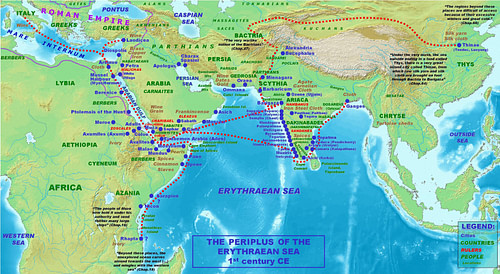Eleusis has been on my wish list for many years. For some reason or
another, my visit was always postponed or canceled. But after much perseverance
and determination, the opportunity arose, and I walked through the very
entrance to the site.
It so happens
that this was where the Sacred Way ended, the one on which in antiquity the
procession had started, leaving the Kerameikos in Athens. All that
remains is a large paved area, once framed by two arches. [The picture shows the Sacred Gate at the Kerameikos in Athens]
We owe the
earliest version of the Eleusinian Mystery to an unknown poet from the 6th
century BC who composed the Homeric
Hymn to Demeter. The Hymn describes the abduction of Persephone (or
Kore), Demeter’s daughter, by her uncle, Hades, god of the Underworld. Demeter,
the goddess of the earth and fertility of the land, set out on a desperate
adventure to find her back. On her search, she rested here at Eleusis,
where she found hospitality. To thank King Celeos
and the people of Eleusis for their kindness, she
rewarded them with the knowledge of agriculture and the “Mysteries” – sacred
wisdom to be experienced and learned at Eleusis.
Demeter’s quest
continued, however. Overcome by sadness, she searched long and far
relentlessly. Immersed in grief and loss, the seasons stopped, and living
things ceased to grow and died. Facing the extinction of life on earth,
Zeus, the brother to both Hades and Demeter and father to Persephone,
intervened, commanding Hermes to bring Persephone back. However, because she
had consumed some pomegranate seeds while with Hades, she was obliged to stay
with him. As the order given by Zeus could not be ignored, the compromise was
that Persephone would spend four months each year with Hades. These are the
winter months. With Persephone's return to the surface of the earth comes
spring, the planting of the seeds, summer, and the harvest in autumn.
Over time, the
Eleusinian Mysteries were open to everybody, male, female, or even slaves, as
long as they followed the prescribed initiation. Eventually, most of Athens’ citizens, among which
we count Pericles
and Aristotle,
were initiated and joined by prominent Romans like Marcus Aurelius.
We know
little about the formalities around the annual Mysteries but almost nothing
about their secret rituals. The celebration, which started in autumn, lasted nine
days. This began with preparations, purification rites, and sacrifices in Athens proper. On the
fifth day, the procession moved to Eleusis
along the 20km Sacred Way.
Several days of
festivities at Eleusis
followed, including the initiation proper, lasting an entire night. Otherwise,
we have little insight into the rites because the participants were sworn to
secrecy, and disclosing the mystery was a capital offense. One thing that
transpires is that initiation helped to reduce one’s fear of death. Many
writers imply that participating permanently and positively changed their
lives. Cicero, for instance,
stated that initiated gained
the power not only to live happily but also to die with a better hope.
The Eleusinian
Mysteries remained popular for at least eight centuries. As Eleusis was
part of Athens’
territory, the latter gained much prestige and fame. Christianity, here as
elsewhere, gradually took over.
Before entering
the Sanctuary through the Greater Propylaea, one cannot miss the Temple of Artemis on the right-hand side. It dates
from the 2nd century AD when much of the Sanctuary was reconstructed and
expanded. All that’s left of this temple is the crepidoma and bits of columns
among other pieces of architecture.
The Greater
Propylaea, also from the 2nd century AD, has left more vestiges. This tall entrance
gate was a reduced copy of the better-known Propylaea at the Acropolis in Athens, built some 600
years earlier. It was erected by Emperor Hadrian and finished by Marcus Aurelius.
Slightly behind
this majestic gateway is a large cave-like opening in the rock considered an
entrance to the Underworld. There was a small temple dedicated to Hades (the
Roman Pluto).

The primary
building and heart of the sanctuary was the enormous Telesterion, where the Mysteries were celebrated. It was conceived by Tyrant Peisistratus upon
instructions of Athens.
Three sides of the inner space were occupied by seven rows of seats allowing a
crowd of participants to observe what happened. Five rows of Ionian columns
supported one of the most extensive roofs in the world (50x50m). The entrance
on the southeast was protected by a portico supported by twelve columns of
white marble standing in stark contrast with the dark stones of the outer
walls. The Telesterion kept the most important element of the megaron, the Adyton, which coincided
with the Anaktoron,
the sanctum sanctorum.
Here the sacred objects were kept only shown to those initiates and officials
of the Mysteries who were allowed to enter.
This marvelous
construction was destroyed during Xerxes’ expedition, but soon plans arose to
rebuild it twice the size of Peisistratus’
concept. Being too ambitious, the Telesterion was reduced to the rectangular
shape we recognize today, offering seating for 4,000 people.
Of course, it
takes a lot of imagination to picture this unusual structure since all there is
left to see is this wide paved area dotted with a few stubs of columns. The
rock-cut tiers of seating are the most remarkable remnant of this striking
building. The memory of the place is still there, but only limited evidence of
what went on inside.
At the far end
of the site is a small museum worth the visit, as always. The most striking
relief of Demeter and Persephone has been moved to the National
Archaeological Museum
in Athens, but
a copy is kept within these walls.
It’s only on the
way back that I notice the remains of the Lesser Propylaea, about halfway
between the Greater Propylaea and the Telesterion. Noteworthy is the Roman
relief on which ears of wheat, Demeter's gift to humankind, are clearly
depicted.



















